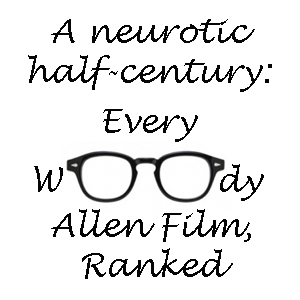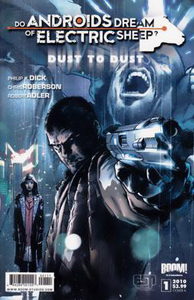“Do Androids Dream of Electric Sheep: Dust to Dust” (2010, Boom! Studios), an eight-issue prequel to Philip K. Dick’s novel (which was being adapted word-for-word by Boom! at this same time), is imperfect but enjoyable. It doesn’t capture PKD’s storytelling style; that’s a high bar, and frankly, it would be weird if it did achieve that.
Revisiting PKD’s world
On the other hand, writer Chris Roberson and the art team stealthily avoid the trap of confusing “DADOES” with “Blade Runner.” “Dust to Dust’s” ideas always come ahead of the action, and the plot is straightforward – in fact, it’s the same plot as “DADOES” as a bounty hunter pursues androids who have escaped their slavery.
Robert Adler, who inks his own pencils, captures PKD’s 21st century San Francisco where humans too poor to move to the colonies are slowly poisoned by radioactive dust. Adler’s almost ephemeral drawings of the characters suggest they are turning into dust already.

“Do Androids Dream of Electric Sheep: Dust to Dust” (2010)
Eight issues, Boom! Studios
Writer: Chris Roberson
Pencils and inks: Robert Adler
Colors: Andrés Lozano, Javier Suppa
Colorists Andres Lozano and Javier Suppa appropriately use blues, blacks and browns. “Dust to Dust,” set in the wake of World War Terminus, marks the beginning of the end for Earth as a place that can support life. This is subtly different from the “Blade Runner” world, where Earth is in a state of change (perhaps for the worse, granted) but maintains huge city populations.
“Dust to Dust” has a more melancholy, resigned vibe. It’s a book about feelings via the characters, too. And here I’ll insert a SPOILER WARNING for those who haven’t read it yet.
Emotional differences
Roberson is interested in the emotional differences between four central characters who trade off first-person POVs. Lead villain Talus, who heads a group of runaway combat androids, sees emotions as humans’ weakness and a lack of emotions as androids’ strength. This is subtly different from PKD’s tenet that androids lack only one specific emotion: empathy.
Ironically, Talus is awash in anger on every panel. He’s so angry about the injustices done to him that he aims to commit genocide against the human race, which isn’t dying out fast enough for his taste. I submit that the desire to commit genocide does not come from cold hard logic, it comes from anger. (I suppose it could also come from sociopathy, but Talus is not portrayed that way.)
Human Malcolm Reed essentially has a super sense of the collective unconscious. Imagine Buffy in the Season 3 episode “Earshot” wherein she hears everyone’s thoughts, except that Reed – one of those “specials,” thanks to the radiation — reads emotions. But only those of humans, not of androids.

Understandably borderline insane from being bombarded by people’s feelings, Reed is the reluctant sniffer for Charlie Victor, a bounty hunter who ironically happens to be an android himself. Although he would at first blush seem utterly machine-like, Charlie (like every main character) is thoughtful. He deduces that beings’ identities are the result of their experiences.
The CV series (yes, Charlie Victor’s name is very on-the-nose) was given the ability to adapt on the battlefield. Because every soldier’s experiences differ slightly, the paths of Talus and Charlie gradually diverged. It’s rather bold of Roberson that Charlie never diverts from his bounty hunting mission out of a sense of loyalty to “his people.” But it also makes sense: Charlie, unlike Talus, falls back on cold, hard programming.
Mercer, Penfield and Buster
The fourth main character, Samantha Wu, is the audience surrogate. Through her, we get a peek into the evolution of the Mercerism empathy box and the mood organ eventually designed by Dr. Penfield. He is Sam’s boss at a science lab trying to figure out why the radiation has devastated animals more than humans. These references are little more than Easter eggs from Roberson, albeit welcome ones.
But I find it odd that the empathy box predates the mood organ. Penfield creates his device – where the user can dial up the mood they want to have — by expanding the principles of the empathy box. It seems like the ultra-specific targeting of the empathy box – visions of Mercer and a feeling of deep communion with him, which leads to conversion to Mercerism – would be more difficult to implant in someone’s brain than general moods. (But maybe not.)
Also, the TV show “Buster Friendly and His Friendly Friends” post-dates Mercerism, which contradicts my theory from reading “DADOES” that they were created simultaneously in order to control the population via the false binary method.
Beyond empathy
I’m not sure if Roberson mistakenly equated the terms “empathy” and “emotions” or if he is simply branching off from PKD’s concept via this CV line of androids. The “Blade Runner” replicants definitely have emotions (think of Roy Batty), but a case could be made that PKD’s androids don’t. That’s why Rachel Tyrell, nee Rosen, is the most PKD-ish of “BR’s” replicants; Sean Young perfectly plays her as cold and distant.
In “Dust to Dust,” Talus and his AWOL colleagues have strong emotions throughout. Reed’s powers can’t detect them — because he only detects human emotions — but a reader can see them plainly in Adler’s drawings and Roberson’s dialog.
Roberson tip-toes further into the arena of androids having equivalent traits to humans, but not the same traits, when Wu patches up Charlie’s injured abdomen. He has wires inside. We later learn those wires are part of an implanted bomb, but I initially thought the wires were the equivalent of capillaries.
I realize that Roberson, even though he takes us through a history of AI that includes computerized robots, does understand that PKD’s androids are physically identical to humans. This is something that casual observers sometimes get wrong; they sometimes confuse androids/replicants with Terminators. PKD’s point, continued in “Blade Runner,” is that only empathy distinguishes humans from androids.
Roberson’s decision to expand “empathy” to “all emotions,” but to also show Talus as the most emotional character, muddies the waters of “Do Androids Dream of Electric Sheep.” But I should grant that the CV series is different from the later Nexus-6 series, which the Voight-Kampff Test targets. And ultimately, “Dust to Dust,” as an idea-based series, achieves its primary aim of giving me things to think about.

